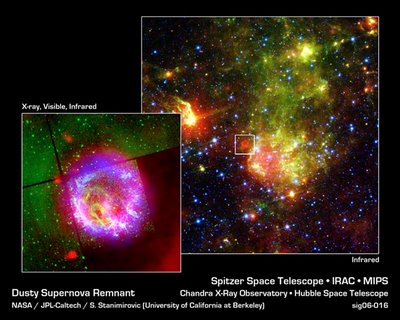The closeup of E0102 on the left is a composite of the infrared observations by Spitzer (red), an optical image (0.5 micron oxygen emission line) captured by the Hubble Space Telescope (green), and X-ray measurements by NASA's Chandra X-ray Observatory satellite (blue). The X-ray ring is generated when the reverse shock slams into stellar material that was expelled during the explosion.
Releases from NASA, HubbleSite, Spitzer, ESO, ESA, NASA’s Chandra X-ray Observatory, Royal Astronomical Society, Harvard-Smithsonian Center For Astrophysics, Max Planck Institute, Gemini Observatory, Subaru Telescope, W. M. Keck Observatory, JPL-Caltech, ICRAR, Webb Space Telescope, etc
